Of late, Kerala has been in the news quite a bit, first for the Nipah virus scare, and then the floods and disease spikes in their wake. However, the state has remained extremely well prepared to respond to these public health and infectious disease challenges. As I was perusing some of the statistics reported from the state for the past year, for some other work, I thought of putting down my reflections in the form of a quick blog post analyzing the outbreaks reported from the state in the past 12 months. I have sourced the data from the Integrated Disease Surveillance Program website’s weekly outbreaks reports. Of course, the validity of any and all analysis and reflections depends on the accuracy and validity of these data, but since I have no other standard to that I can compare with (without having to invest extra time, effort and money), I am going to work off these data points. Further, since these are government generated data, they are more likely to find their way into the policy making realms. I looked at the outbreaks reported between the 21st week of 2018 (21st May to 27th May, 2018) to the 20th week of 2019 (13th May to 19th May 2019), which is the most recent data available at the time of writing this post.
Demographics of Kerala
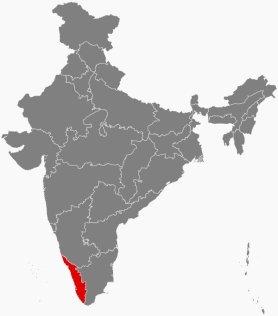 Kerala, India
Kerala, IndiaThe southern Indian state of Kerala is home to about 33 million people, and was the 13th largest state in terms of population according to the 2011 census. It is divided into 14 districts, which form the administrative and policy making units in most public health programming. Kerala has the highest literacy rate in India, almost 94%, and the gender ratio stands at 1.084, in comparison to the national ratio of 0.940. Kerala has the highest life expectancy of all states in India. Kerala also boasts of sub-replacement fertility rates. In this one year period, there were 104 reported outbreaks of various infectious diseases from Kerala.
Outbreaks: Locations
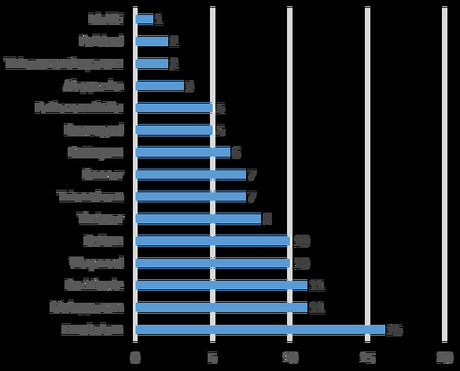 District-wise number of outbreaks
District-wise number of outbreaksThe outbreaks represented a fairly large part of the state, although almost 60% of the outbreaks could be accounted for by Ernakulum, Malappuram, Kozhikode, Wayanad and Kollam. Interestingly, Wayanad, which is the least populous district of Kerala, figures prominently, with a skewed number of outbreaks happening there. Ernakulum and Malappuram are one and three in the population ranking for the most populous districts in Kerala, according to the 2011 census.
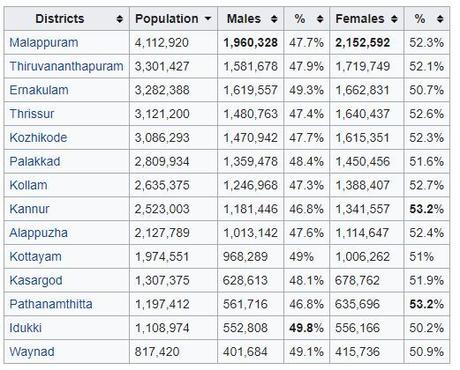 District-wise population of Kerala: 2011 census (Wikipedia)
District-wise population of Kerala: 2011 census (Wikipedia)Outbreaks: Diseases
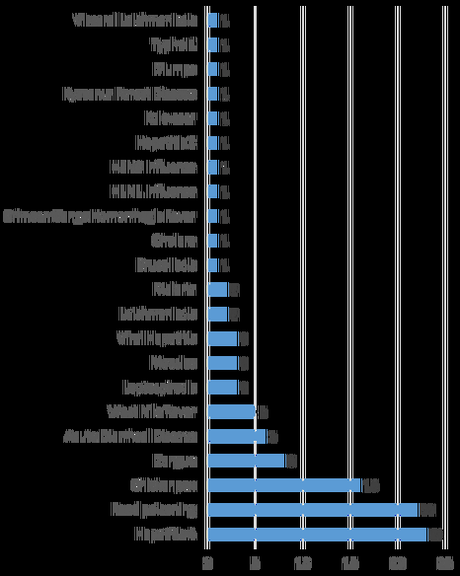 Number of Outbreaks in Kerala May 2018-May 2019
Number of Outbreaks in Kerala May 2018-May 2019The most commonly reported outbreaks were hepatitis A and food poisoning, accounting for almost half of all the outbreaks. There was only one outbreak of cholera, and interestingly, there was even an outbreak of Crimean Congo Hemorrhagic Fever (admittedly represented by a single patient), which was something that surprised me. The IDSP provides some details related to this case. It seems that the case began its clinical trajectory whilst in UAE, and culminated in India. A lot of doubts still remain after reading the IDSP narrative; I am providing it in full (edited only for grammar and syntax) below.
CCHF in Kerala
A 31-year old male native of Malappurum, working as a butcher in Abu Dhabi, UAE, returned to Cochin on 29th November 2018. During his journey he presented with headache and was admitted to a Private Hospital in Cochin. District RRT (Rapid Response Team) investigated the outbreak.
IDSP Weekly Outbreaks report
- On 15th November 2018 the case was admitted in a hospital in Abu Dhabi, UAE with symptoms of high grade fever, headache, body pain, myalgia and vomiting.
- Blood sample was positive for CCHF (by PCR).
- He was treated in a hospital at Abu Dhabi, UAE. On 25th November 2018, the blood sample was negative for CCHF and was discharged from the hospital.
- 3 more cases were reported from the affected area and were treated in locally in Abu Dhabi, UAE.
Active search for cases conducted and contacts were traced. 2 blood samples were collected and sent to Manipal Center for Virus Research, Manipal. They were both negative for CCHF. Infection control measures were undertaken at the hospital where the patient was admitted. No new cases were reported. Health education given.
 District-wise outbreaks in Kerala
District-wise outbreaks in KeralaSome other interesting trends can be picked up if one looks at the spread of the outbreaks over the various districts. In the table above I have provided some of the major outbreaks in a district wise pattern. I have left out a few diseases, hence the total will not make it up to 104, which was the total number of reported outbreaks. Interestingly, there were 5 outbreaks of West Nile Fever, and in all five occasions, they took place in Kozhikode. Although there were only three outbreaks of Leptospirosis, one of them was in the wake of the floods, and resulted in 590 cases and 8 deaths in Ernakulum (35th reporting week, 2018).
Post-Flood Leptospirosis
The IDSP report for the 35th reporting week, 2018, identifies a large outbreak of leptospirosis. Although the report attributes the cases to Ernakulum, the narrative appended along with it provides a slightly different picture. I am providing the comment in full, edited only slightly for grammar and syntax, with no change in its sense.
Cases were reported from multiple flood affected districts: Ernakulam, Alappuha, Pathanamthitta, Thrissur, Palakkad, Malappuram and Kozhikode. District RRT investigated the outbreak. House to house surveys were done. 158 cases were confirmed using IgM ELISA for Leptospirosis at DPHL (District Public Health Laboratory), Medical College and referral labs. All cases were treated symptomatically. Intensive preventive measures were implemented. Arrangements were made for early recognition and treatment. Chemoprophylaxis using Doxycyclin capsules was given to all persons exposed to flood water as well as to those engaged in rescue activities. Community was made aware of signs and symptoms of disease and measures of prevention.
IDSP Weekly Outbreaks report
Outbreaks: Case Counts
Now I realize that this is perhaps the least reliable metric, since they are subject to a lot of variability, but since the data was available, I decided to quickly summarize it anyway.
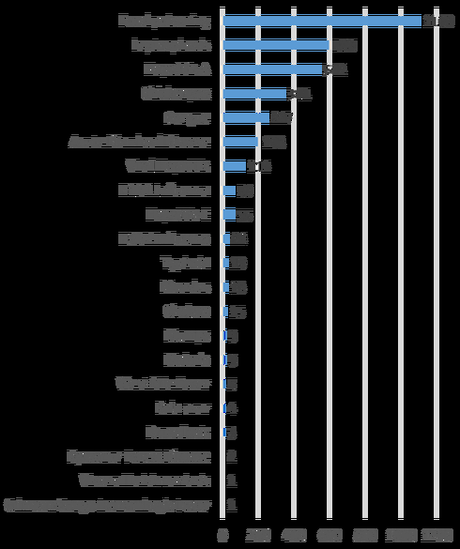 Case counts from Kerala Outbreaks
Case counts from Kerala OutbreaksFood poisoning, which was one of the commonly occurring reported outbreak, naturally accounted for the highest number of cases, with the post-flood tide of Leptospirosis claiming the second largest number of cases.
Nipah Virus Outbreak in Kerala
So, amidst all of this, where is the Nipah virus outbreak, one may ask… or at least I was asking. I checked the WHO website, and it states that the Nipah Virus outbreak began in Kerala on 19th May, 2018, which falls in the period for which I extracted the data. It is not mentioned in any of the weekly reports (or if it is mentioned, I may have missed it – do let me know if that is indeed the case). The WHO website mentions:
On 19 May 2018, a Nipah virus disease (NiV) outbreak was reported from Kozhikode district of Kerala, India. This is the first NiV outbreak in South India. There have been 17 deaths and 18 confirmed cases as of 1 June 2018. The two affected districts are Kozhikode and Mallapuram. A multi-disciplinary team led by the Indian Government’s National Centre for Disease Control (NCDC) is in Kerala in response to the outbreak. WHO is providing technical support to the Government of India as needed. WHO does not recommend the application of any travel or trade restrictions or entry screening related to NiV outbreak.
WHO Website
However, if one navigates to the website of the Directorate of Health Services, Kerala, and looks up the reports generated for the year of 2018, one can find that there is clearly the mention of the devastating Nipah Virus outbreak there. Yet, this did not figure in the weekly report published for the corresponding week on the IDSP website and the reason for the same is not quite clear to me.
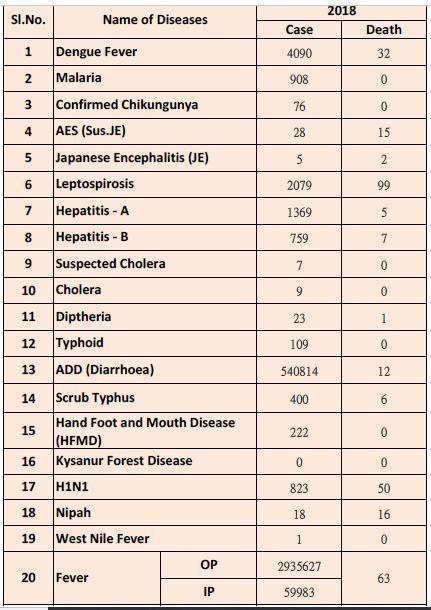 Data on communicable diseases: Kerala
Data on communicable diseases: KeralaSumming up…
Whilst the limitations of outbreak reporting remains clearly documented, and the challenges in providing up to the date data on outbreaks as they happen is a problem a lot of resilient systems have not been able to solve, there still remains a lot of value that can be attached to perusal of outbreaks data from the IDSP system. The large threat of infectious diseases clearly remains; on an average, about 9 infectious disease outbreaks hit one part of another of Kerala, throughout the last year. This number is likely to be similar to data being reported from other parts of the country as well. If nothing else, then this is a strong indicator that whilst the non-communicable disease challenge needs to be met with a strong and decisive hand, it should not come at the cost of resources allocated to meeting the infectious disease threats looming large over India. We are still at that uncomfortable cusp, where we have to deal with the dual threats of communicable and non-communicable disease burdens.
